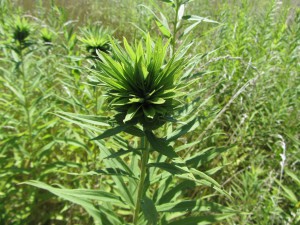After the showy flowers have turned to seed, and the leaves have dropped, it’s easier to see the shape of the stems left standing, and to wonder: what causes the swelling on stems of goldenrods?
Spindle-shaped stem swellings, balls on leaves or stems, even tight rosettes of leaves are all galls, created by a plant in response to an insect laying eggs on the plant. Each forms when a wasp, fly, moth, or midge lays an egg, the egg hatches and the larva begins to feed on the goldenrod. The larva’s saliva contains chemicals that cause the plant to produce the gall, by thickening the plant’s stem, or in the case of the rosette, inhibiting the stem’s growth without inhibiting the leaves, causing the leaves to pile up on one another and form the rosette.
Each gall is specific to a particular species of insect and plant. Female gall wasps “taste” goldenrod to check that it’s the correct species, first with receptors on her feet, and then with her ovipositor which pierces the plant’s stem to deposit the eggs. Scientists know this because they wrapped a stem of one goldenrod with the outer sheath of another—the wasp refused to deposit her eggs on the wrong type of goldenrod. Oaks are another common host for insect galls.
Larvae develop in the galls, eating and growing until they’re ready to pupate. Both the ball and spindle galls house the larvae over winter. The larvae themselves cope with these unheated houses by producing their own anti-freeze. The larvae can endure multiple freeze-thaw cycles during the winter, but may face predators.
Parasitic wasps may deposit eggs within the gall. Their larvae will feed upon the original gall-maker and its house. Woodpeckers and chickadees have also discovered that galls contain tasty grubs and will peck open the gall to eat the insect inside.
Diane Greening


